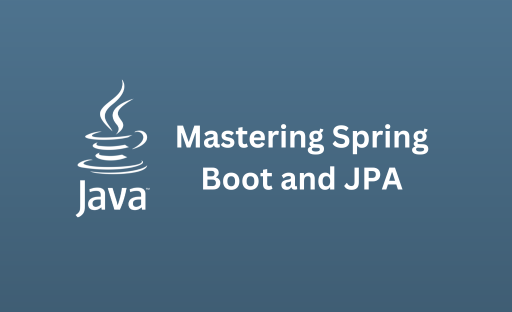“Learn Spring Boot and JPA with this comprehensive guide. Understand Java Persistence API through simple examples and prepare for interviews with key questions.”
Introduction: Explaining Spring Boot and JPA
Imagine you have a magical notebook. Whatever you write in it gets stored forever, and you can search for it later without flipping through all the pages. Now imagine that your notebook can talk to your computer and show the information on your screen.
- Spring Boot is like the computer program that helps you connect with your magical notebook.
- JPA (Java Persistence API) is the special magic spell that makes it easy to store, find, update, and delete things in your notebook.
In the world of programming, this “magical notebook” is called a database. Let’s build something using these tools to understand them better.
Table of Contents
Getting Started with Spring Boot and JPA
1. Setting Up Spring Boot
First, create a Spring Boot project using Spring Initializr:
- Go to start.spring.io.
- Add the following dependencies:
- Spring Web (to create REST APIs)
- Spring Data JPA (to use JPA)
- H2 Database (for an in-memory database)
Download the project, unzip it, and open it in your IDE.
2. Creating a Simple Example: “Book Store Application”
We will create a simple application to manage a collection of books. Each book has an id, title, author, and price.
Step 1: Define the Book Entity
In JPA, we represent database tables as Java classes. Here’s how to define a “Book” entity:
File: src/main/java/com/example/demo/entity/Book.java
javaCopy codepackage com.example.demo.entity;
import jakarta.persistence.Entity;
import jakarta.persistence.GeneratedValue;
import jakarta.persistence.GenerationType;
import jakarta.persistence.Id;
@Entity
public class Book {
@Id
@GeneratedValue(strategy = GenerationType.IDENTITY)
private Long id;
private String title;
private String author;
private double price;
// Getters and setters
public Long getId() {
return id;
}
public void setId(Long id) {
this.id = id;
}
public String getTitle() {
return title;
}
public void setTitle(String title) {
this.title = title;
}
public String getAuthor() {
return author;
}
public void setAuthor(String author) {
this.author = author;
}
public double getPrice() {
return price;
}
public void setPrice(double price) {
this.price = price;
}
}
Explanation:
@Entity: Marks the class as a JPA entity (table in the database).@Id: Marks the primary key.@GeneratedValue: Automatically generates a value for the primary key.
Step 2: Create the Repository
A repository handles database operations for the entity.
File: src/main/java/com/example/demo/repository/BookRepository.java
javaCopy codepackage com.example.demo.repository;
import com.example.demo.entity.Book;
import org.springframework.data.jpa.repository.JpaRepository;
public interface BookRepository extends JpaRepository<Book, Long> {
}
Explanation:
- Extending
JpaRepositorygives us built-in methods for CRUD operations (e.g.,save,findById,deleteById).
Step 3: Create the Service Layer
The service layer contains business logic.
File: src/main/java/com/example/demo/service/BookService.java
javaCopy codepackage com.example.demo.service;
import com.example.demo.entity.Book;
import com.example.demo.repository.BookRepository;
import org.springframework.beans.factory.annotation.Autowired;
import org.springframework.stereotype.Service;
import java.util.List;
@Service
public class BookService {
@Autowired
private BookRepository bookRepository;
public List<Book> getAllBooks() {
return bookRepository.findAll();
}
public Book addBook(Book book) {
return bookRepository.save(book);
}
public void deleteBook(Long id) {
bookRepository.deleteById(id);
}
}
Step 4: Create the Controller
The controller handles HTTP requests.
File: src/main/java/com/example/demo/controller/BookController.java
javaCopy codepackage com.example.demo.controller;
import com.example.demo.entity.Book;
import com.example.demo.service.BookService;
import org.springframework.beans.factory.annotation.Autowired;
import org.springframework.web.bind.annotation.*;
import java.util.List;
@RestController
@RequestMapping("/api/books")
public class BookController {
@Autowired
private BookService bookService;
@GetMapping
public List<Book> getAllBooks() {
return bookService.getAllBooks();
}
@PostMapping
public Book addBook(@RequestBody Book book) {
return bookService.addBook(book);
}
@DeleteMapping("/{id}")
public void deleteBook(@PathVariable Long id) {
bookService.deleteBook(id);
}
}
Explanation:
@RestController: Handles RESTful web requests.@RequestMapping("/api/books"): Maps all requests to/api/books.@GetMapping,@PostMapping,@DeleteMapping: Handle GET, POST, and DELETE HTTP methods.
Step 5: Test the Application
Run the application and test the API using Postman or a similar tool. The H2 database console is available at http://localhost:8080/h2-console.
Understanding Key JPA Concepts
- Entity: A class representing a table in the database.
- Primary Key: The unique identifier for each record.
- Repository: Interface to manage database operations.
- Transactions: Ensure data consistency (Spring handles them automatically).
Spring Boot and JPA Interview Questions
Beginner-Level Questions:
- What is Spring Boot, and how does it simplify development?
- Explain the role of JPA in Spring Boot.
- What is the difference between
@Entityand@Tableannotations?
Intermediate-Level Questions:
- What are the advantages of using
JpaRepositoryoverCrudRepository? - How do you handle transactions in Spring Boot?
- What is the purpose of the
@GeneratedValueannotation?
Advanced-Level Questions:
- Explain the N+1 query problem and how to solve it in JPA.
- How can you optimize performance with JPA caching mechanisms?
- Discuss the differences between
LAZYandEAGERfetching strategies.

